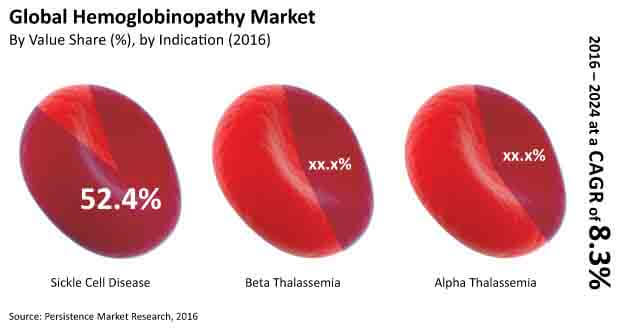Hemoglobinopathy Market Segmented By Sickle Cell Disease, Beta Thalassemia, Alpha Thalassemia Indication with Routine Red Blood Cell Count, Genetic Testing, Hemoglobin by High Performance Liquid Chromatography, Hemoglobin Isoelectric Focusing, Hemoglobin electrophoresis, Hemoglobin Solubility Test
Industry: Healthcare
Published Date: October-2016
Format: PPT*, PDF, EXCEL
Delivery Timelines: Contact Sales
Number of Pages: 131
Report ID: PMRREP10007
Hemoglobinopathies are a diverse set of congenital blood ailments that are a consequence of disparities in the structure and/or synthesis of hemoglobin. Hemoglobinopathies are genetic single-gene disorders that lead to an abnormal structure of one of the globin chains of the hemoglobin molecule, rendering it unable to carry oxygen through the body, which leads to anemia or other medical abnormalities.
The most common hemoglobinopathies are sickle cell disease, alpha thalassemia, and beta thalassemia. The global hemoglobinopathy market is projected to register a CAGR of 8.3% during the forecast period in terms of value and is expected to reach a market valuation of US$ 788.2 Mn by the end of 2024.
Growth of the global hemoglobinopathy market is mainly driven by a growing prevalence of hemoglobinopathies in developed nations, high disease occurrence in underdeveloped nations, various supportive government initiatives, and non-government organizational funding.
Other factors driving the global hemoglobinopathy market are advanced diagnostics and therapeutics, favorable reimbursement scenario for diagnostic tests and treatment, cost-effective preventive approach like genetic testing, and development of rapid point-of-care diagnostic methods.
However, lack of awareness regarding hemoglobinopathy disorders amongst the population especially in underdeveloped countries and lack of high sensitivity and specific diagnostic tests are expected to restrain growth of the market over the forecast period. Focus on novel diagnostic approaches and development of fast, reliable, and cost-effective diagnostic methods will define the future landscape of the global hemoglobinopathy market.
The global hemoglobinopathy market has been segmented on the basis of indication, test type, end users, and region. Based on indication type, the market has been segmented into sickle cell disease, alpha thalassemia, and beta thalassemia. Sickle cell disease segment is expected to be the most lucrative segment in the global hemoglobinopathy market owing to increasing incidences of sickle cell disease. In terms of value, sickle cell disease segment is estimated to account for 52.4% share of the global hemoglobinopathy market by 2016 end.
Based on major end users, the global hemoglobinopathy market is segmented into hospitals, diagnostic laboratories, and clinics. Diagnostic laboratories followed by hospitals are expected to account for the highest share of the global hemoglobinopathy market over the forecast period. In terms of value, diagnostic laboratories segment is estimated to account for the highest market share of 49.4% of the global hemoglobinopathy market by 2016 end.
Based on the test types, the market has been segmented into red blood cell (RBC) count test, genetic testing, hemoglobin by high performance liquid chromatography (HPLC) test, hemoglobin isoelectric (Hb IEF) focusing, hemoglobin electrophoresis (Hb ELP) test, and hemoglobin solubility test.
Red blood cells (RBC) count test segment currently accounts for the highest revenue of the global hemoglobinopathy market owing to the fact that it is a basic test performed prior to most hemoglobinopathy diagnosis tests. In terms of value, routine red blood cell (RBC) count segment is estimated to account for the highest market share of 30.4% by 2016 end.

The global hemoglobinopathy market has been segmented into five major regions: North America, Latin America, Europe, Asia Pacific (APAC), and Middle East & Africa (MEA). In terms of value, Europe is estimated to be the dominant regional market in the global hemoglobinopathy market in 2016 owing to a robust healthcare infrastructure and high prevalence of thalassemia in Mediterranean countries like Cyprus and Greece.
The Europe hemoglobinopathy market is expected to register a CAGR of 7.9% over the forecast period. Asia Pacific and Middle East & Africa are estimated to be the fastest growing markets in terms of CAGR. The North America hemoglobinopathy market is expected to register a CAGR of 7.6% over the forecast period.
Some key players in the global hemoglobinopathy market are Abbott Diagnostics, Bio-Rad Laboratories Inc., Danaher Corporation, Mindray Medical International Ltd., Nexcelom Bioscience LLC., Nihon Kohden Corporation, PerkinElmer Inc., Siemens Healthineers, and Sysmex Corporation. Manufacturers are focused on manufacturing cost-effective and rapid diagnostic methods. Furthermore, companies operating in the global hemoglobinopathy market are focusing on the development of novel point-of-care diagnostic tests.
To know more about delivery timeline for this report Contact Sales
